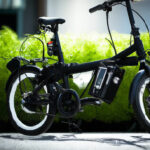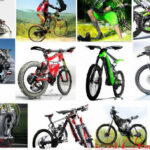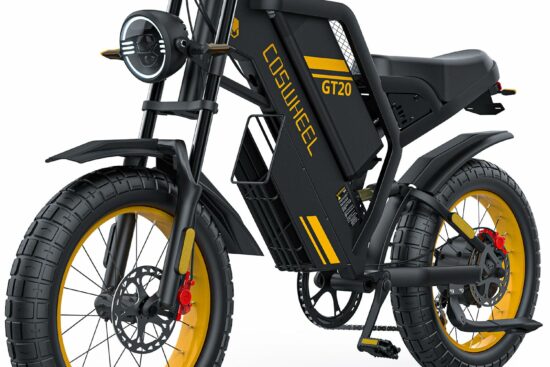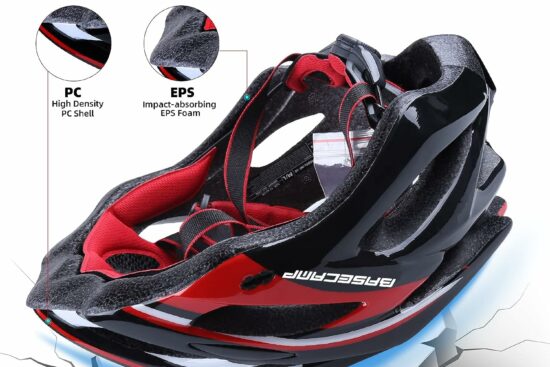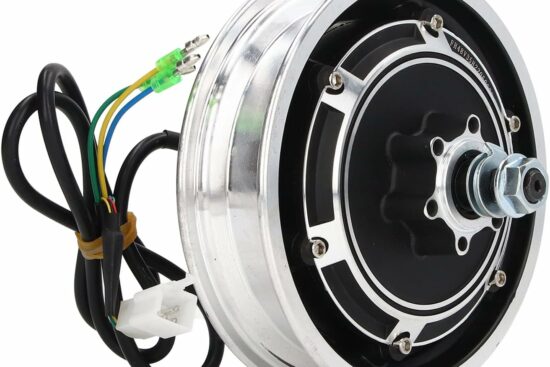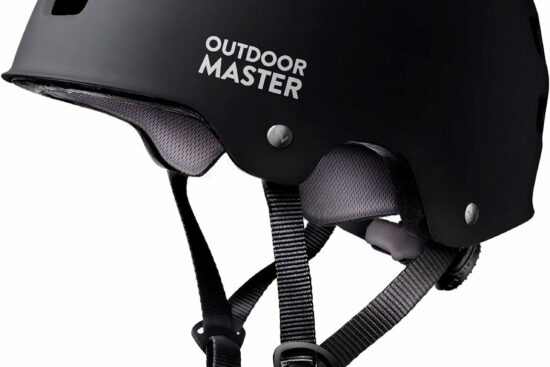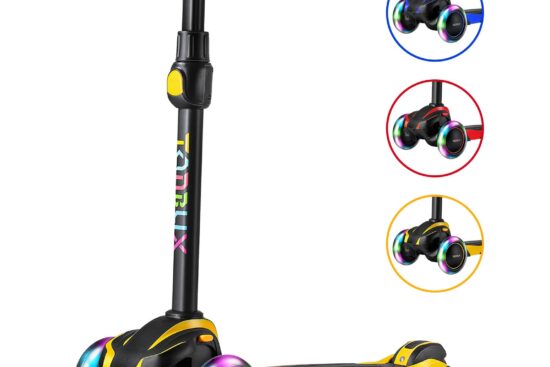
Rainy conditions can present unique challenges when it comes to riding an electric bike. With slippery surfaces and reduced visibility, it becomes crucial to ensure your safety. In this article, you will discover essential tips and techniques to safely ride an electric bike in rainy conditions. From selecting the right tires to maintaining proper body position, these guidelines will enable you to confidently navigate the wet streets and enjoy a smooth and secure ride. Embrace the rain and make the most of your electric bike with these essential safety precautions.

1. Prepare Your Electric Bike
1.1 Ensure Proper Tire Tread
Before embarking on a ride in rainy conditions, it’s crucial to ensure that your electric bike’s tires have adequate tread. The tread on your tires is what provides traction, allowing you to maintain control on wet surfaces. To check the tire tread, simply examine the grooves on the surface of the tire. If the tread appears worn or shallow, it’s time to replace the tires. Riding with worn-out tires increases the risk of slipping and losing control, especially on slippery surfaces.
1.2 Check the Brakes
In wet conditions, having reliable brakes is essential for your safety. Take a moment to inspect your electric bike’s brakes before heading out. Check if the brake pads are worn and need replacement. When applying the brakes, ensure that they engage smoothly and effectively. If you notice any issues with your brakes, such as reduced responsiveness or excessive squeaking, have them inspected and serviced by a professional. Remember that well-functioning brakes are crucial for stopping safely, especially in wet weather.
1.3 Inspect the Lights
Visibility is key when riding in rainy conditions, as reduced visibility can increase the risk of accidents. Before setting off, check that all the lights on your electric bike are in proper working order. Test the headlights, taillights, and turn signals to ensure they are functioning correctly. If any of the lights are not working or are dim, replace them promptly. Having fully functional lights ensures that you are visible to other road users and can effectively signal your intentions when riding in rainy conditions.
1.4 Test the Battery
A reliable and fully charged battery is essential for a smooth and uninterrupted ride, regardless of the weather conditions. Before heading out, test your electric bike’s battery to ensure that it is fully charged and functioning correctly. If your battery isn’t holding a charge or shows signs of diminished performance, consider replacing it or having it serviced by a professional. Riding with a low or unreliable battery in rainy conditions can put you at risk of your electric bike losing power unexpectedly.
1.5 Clean and Lubricate the Chain
Riding in rainy conditions can result in increased dirt and grime buildup on your electric bike’s chain. A dirty or poorly lubricated chain can lead to decreased performance and potential damage to the drivetrain. Therefore, it’s essential to clean and lubricate your bike’s chain before heading out in the rain. Use a mild detergent and water to clean the chain, ensuring that all debris is removed. Once clean, apply a suitable bike chain lubricant to ensure smooth operation. A well-maintained chain will provide better shifting, increase efficiency, and prolong the life of your electric bike.
2. Wear Appropriate Protective Gear
2.1 Helmet
A helmet is a fundamental piece of protective gear that should be worn at all times when riding an electric bike, regardless of the weather conditions. When riding in the rain, the likelihood of slippery surfaces and potential accidents increases. Wearing a properly fitted and certified helmet significantly reduces the risk of head injuries in case of a fall or collision. Ensure that your helmet fits snugly and covers the forehead, providing adequate protection for the most vulnerable part of your head.
2.2 Waterproof Clothing
Investing in waterproof clothing is crucial when riding an electric bike in rainy conditions. Wearing waterproof jackets, pants, and shoe covers will protect you from getting soaked and keep you comfortable during your ride. Look for garments made from high-quality materials that are both waterproof and breathable, allowing moisture to escape while keeping you dry. Remember to also consider wearing rainproof gloves to maintain a secure grip on the handlebars, even when wet.
2.3 Non-Slip Shoes
Choosing the right footwear is essential for maintaining control and stability when riding in wet weather. Opt for shoes with non-slip soles that provide excellent grip on wet surfaces. Avoid wearing footwear with smooth or worn-out soles, as they can significantly increase the chances of slipping and losing control of your electric bike. Consider investing in waterproof shoes or shoe covers to keep your feet dry and comfortable throughout your ride.
2.4 Protective Eyewear
Protecting your eyes from rain, wind, and debris is crucial for maintaining clear vision and avoiding potential hazards on the road. Wearing suitable protective eyewear, such as cycling glasses or goggles, will shield your eyes and enhance visibility in rainy conditions. Look for eyewear with anti-fog coatings and lenses that provide optimal clarity. It is important to have unobstructed vision while riding to anticipate and react to any potential obstacles or hazards.
2.5 Reflective Gear
Visibility is of utmost importance when riding an electric bike in rainy conditions, especially in low-light situations. Wearing reflective gear will significantly improve your visibility to other road users. Invest in reflective vests, bands, or accessories that can be easily seen by drivers and pedestrians, increasing your chances of being noticed. Adding reflective gear to your outfit enhances your safety on the road by making you more visible, particularly in poor weather conditions.
3. Plan Your Route Wisely
3.1 Choose Well-Maintained Roads
When riding in rainy conditions, it’s essential to select roads that are well-maintained and free of major potholes or defects. Poorly maintained roads can have hidden hazards, making it difficult to navigate safely, especially in wet weather. Plan your route using roads that you are familiar with and that have good drainage systems to minimize the risk of encountering deep puddles or slippery surfaces.
3.2 Avoid Puddles and Standing Water
Puddles and standing water can be extremely hazardous when riding an electric bike in rainy conditions. It’s essential to avoid these areas as they can hide potholes, debris, or other potential dangers. When encountering puddles, try to change your path or slow down to minimize splashing and potential loss of control. Remember that shallow-looking puddles can sometimes be deeper than they appear, so exercise caution and maintain a safe distance from them.
3.3 Check Weather Forecasts
Before heading out on your electric bike, always check the weather forecasts to ensure you are prepared for the expected conditions. Rainfall intensity, wind speed, and thunderstorm alerts are crucial factors to consider when planning your ride. Avoid riding in severe weather conditions, such as heavy downpours, strong winds, or lightning storms, as these conditions can significantly impact your safety on the road. It is better to postpone your ride or seek shelter until the weather improves.
3.4 Allow Extra Time for Travel
Riding an electric bike in rainy conditions requires extra caution and attentiveness. It’s important to give yourself plenty of time to reach your destination, accounting for potentially slower speeds and increased traffic. Rushing in wet weather can compromise your safety and increase the likelihood of accidents. Plan your journey in advance, allowing an additional buffer of time to adapt to changing road conditions and ride at a controlled pace.
4. Adjust Your Riding Technique
4.1 Increase Following Distance
Maintaining a safe following distance is crucial when riding an electric bike in rainy conditions. Wet surfaces reduce the friction between the tires and the road, making it harder to stop quickly. Increase your following distance to give yourself ample time to react and come to a controlled stop if necessary. A general rule of thumb is to maintain a distance of at least three seconds behind the vehicle or cyclist ahead of you.
4.2 Brake Gently and Gradually
When riding an electric bike in the rain, it’s important to modify your braking technique to ensure safe and smooth stops. Brake gently and gradually, applying light pressure to avoid sudden skidding or loss of control. Sudden or hard braking can lock up the wheels and cause the bike to skid, potentially resulting in a fall. Take your time to assess the road conditions and give yourself enough stopping distance to brake safely.
4.3 Use Both Brakes Simultaneously
Electric bikes often come equipped with both front and rear brakes, which provide better stopping power when used together. In wet conditions, it’s essential to apply both brakes simultaneously to distribute the braking force evenly. Using only the front or rear brake alone can cause the tires to lose traction and increase the risk of skidding. Practice using both brakes in controlled settings to get a feel for their effectiveness and to ensure proper technique.
4.4 Maintain a Lower Speed
Reducing your speed is a crucial aspect of riding safely in rainy conditions. Wet surfaces decrease traction, making it more difficult to maintain control and stability at higher speeds. Adjust your speed according to the road conditions, allowing for safe and controlled maneuvering. Remember that it takes longer to stop on wet surfaces, so taking a cautious approach and riding at a lower speed can greatly reduce the likelihood of accidents.
4.5 Stay Smooth and Steady
Maintaining a smooth and steady riding style is essential when riding an electric bike in rainy conditions. Avoid sudden or jerky movements, as this can upset your bike’s balance and increase the chances of skidding or losing control. Aim for smooth transitions when accelerating, decelerating, and turning. Focus on your balance and body positioning, keeping your weight centered over the bike to maintain stability. By riding smoothly and steadily, you’ll be better equipped to handle any unexpected situations that may arise.

5. Be Extra Cautious at Intersections
5.1 Approach Slowly and Alertly
Intersections can be particularly hazardous when riding an electric bike in rainy conditions. Reduce your speed and approach intersections with caution, allowing time to assess the traffic and road conditions. Be attentive to traffic signals and the movements of other vehicles, pedestrians, and cyclists. By approaching intersections slowly and attentively, you give yourself additional time to react and make informed decisions, mitigating the risks associated with wet weather.
5.2 Use Hand Signals Clearly
Clear hand signaling is crucial when communicating your intentions to other road users, especially in rainy conditions where visibility may be reduced. Master the proper hand signals for turning and stopping and use them confidently and decisively. Signal well in advance to allow other road users to anticipate your actions and adjust their own accordingly. Utilizing clear hand signals ensures that your intentions are understood, enhancing overall safety on the road.
5.3 Be Visible to Other Road Users
Visibility is key when riding in rainy conditions, and it’s essential to make yourself as visible as possible to other road users. Wear bright and reflective clothing to increase your visibility, even in low-light situations. Position yourself appropriately on the road, maintaining a safe distance from the curb or parked cars. Being visible allows other drivers and cyclists to see you and helps prevent potential accidents caused by inadequate recognition.
5.4 Make Eye Contact with Drivers
When approaching intersections or interacting with other road users, making eye contact with drivers can help establish clear communication and ensure that they have seen you. Whether you are waiting to cross, merging into traffic, or making a turn, making eye contact with drivers before proceeding can help you gauge their level of awareness and intention. This simple action can greatly enhance your safety and reduce the likelihood of collisions or misunderstandings on the road.
5.5 Watch Out for Slippery Surfaces
Rainy conditions can create slippery surfaces at intersections, increasing the risk of skidding or loss of control. Pay particular attention to painted lines, crosswalks, and metal surfaces, as these areas can become especially slick when wet. Approach these surfaces with caution, reduce your speed, and try to ride in a straight line to minimize the risk of slipping. Be aware of any road markings or signs indicating potential hazard areas, and navigate them with care.
6. Enhance Bike Visibility
6.1 Use Bright-Colored Clothing
Wearing bright-colored clothing significantly enhances your visibility on the road, especially in rainy weather with reduced visibility conditions. Opt for high-visibility colors such as fluorescent yellow, orange, or green. These colors stand out against the gray backdrop of rainy days, making it easier for other road users to see you from a distance. A brightly colored jacket or vest can make a considerable difference in ensuring you are noticed and respected by drivers and other cyclists.
6.2 Install Reflectors on the Bike
Reflectors play a crucial role in your bike’s visibility, particularly in low-light or rainy conditions. Check if your electric bike has reflectors installed on the front, rear, and wheels. If not, consider adding them for increased visibility. Reflectors work by reflecting light from other sources, such as headlights, back towards the source, making you more visible to drivers and pedestrians. Ensure that the reflectors are clean and properly aligned to maximize their effectiveness.
6.3 Use Bike Lights
In addition to reflectors, using bike lights is essential for enhancing your visibility, especially when riding in rainy conditions or during periods of limited daylight. Ensure that your electric bike is equipped with front and rear lights that are bright, functional, and adequately angled. Check the batteries or charge levels before each ride to ensure the lights are working at their optimal capacity. Using lights not only makes you more visible but also allows you to see the road ahead more clearly.
6.4 Attach Reflective Accessories
Incorporating additional reflective accessories on your electric bike can further enhance your visibility on the road. Consider attaching reflective tape or stickers to various parts of the bike, such as the frame, pedals, or forks. These reflective accessories help to catch the attention of other road users from different angles, enhancing your overall visibility in wet weather conditions. The more reflective surfaces there are on your bike, the better the chances of being seen and respected by motorists.
6.5 Add LED Light Strips
Another effective way to increase visibility on your electric bike is by using LED light strips. These thin, flexible light strips can be attached to various parts of your bike, such as the frame, handlebars, or fenders. LED light strips are available in different colors and can be set to either a steady or flashing mode, further enhancing their visibility. Ensure that the LED light strips are securely fastened and positioned to provide maximum visibility without obstructing your control or vision.
7. Maintain Proper Distance From Traffic
7.1 Stay Away from Larger Vehicles
When riding an electric bike in rainy conditions, it’s best to maintain a safe distance from larger vehicles such as trucks, buses, or cars. These vehicles create a significant amount of spray, reducing your visibility and potentially causing your electric bike’s tires to lose traction. Riding too closely to larger vehicles can also limit your ability to react to sudden stops or unexpected maneuvers. Give yourself ample space to maneuver safely, ensuring an appropriate safety margin between your electric bike and larger vehicles.
7.2 Anticipate Sudden Stops
One of the key factors in riding safely in rainy conditions is anticipating sudden stops from other vehicles. Wet surfaces significantly increase stopping distances, making it important to give yourself extra time and space to react. Observe traffic patterns and anticipate potential stops from vehicles ahead of you. By remaining vigilant and mentally prepared for sudden stops, you can react in a timely manner and ensure a safe and smooth ride.
7.3 Keep Distance on Busy Roads
Busy roads can be especially challenging to navigate in rainy weather due to increased traffic and potential distractions. It’s crucial to maintain a safe distance from other vehicles to allow for proper reaction time and space. Keep a safe following distance and be cautious of cars switching lanes or cutting across your path. By maintaining distance on busy roads, you can mitigate the risks associated with unpredictable traffic patterns and reduce the likelihood of collisions.
7.4 Maintain a Safe Zone
Creating a safe zone around your electric bike is an important practice to ensure your safety in rainy conditions. This means positioning yourself on the road in a way that allows ample space for you to maneuver safely. Keep a safe distance from the curb or parked cars to avoid potential hazards and allow room to react if necessary. Aim to ride in a position where you are visible to other road users while maintaining a buffer zone that allows for potential hazards.
8. Be Mindful of Slippery Surfaces
8.1 Watch Out for Painted Lines and Crosswalks
Painted lines and crosswalks can become exceptionally slippery when wet, posing a hazard to riders. These surfaces are often smoother than the surrounding road, offering less traction, especially in rainy conditions. Exercise caution when crossing over or riding parallel to painted lines or crosswalks. Reduce your speed and avoid sudden movements to minimize the risk of losing control or skidding. If possible, try to ride on the drier, textured areas of the road to maintain better traction.
8.2 Be Cautious of Metal Surfaces
Metal surfaces, such as manhole covers and train tracks, can be extremely slippery when wet. Exercise caution and reduce your speed when riding over these surfaces to maintain control. Approach metal surfaces at a straight angle whenever possible, as riding diagonally can increase the risk of your bike’s tires slipping. Stay alert and maintain even pressure on the pedals to minimize the chances of skidding or losing control.
8.3 Approach Wet Leaves Carefully
Wet leaves can be deceptively slippery and may conceal potential hazards underneath. Exercise caution when riding over wet leaves, as they can reduce traction and increase the risk of skidding. Reduce your speed and approach wet leaves with care, keeping your weight centered and avoiding sudden movements or braking. Be prepared for a potentially longer stopping distance on wet leaf-covered surfaces and adjust your riding accordingly.
8.4 Be Wary of Sewer Grates
Sewer grates can pose a significant hazard when riding an electric bike in rainy conditions. The metal bars on sewer grates can be especially slippery, making it vital to be wary of them. Approach sewer grates cautiously, reducing your speed and aiming to ride over them at a straight angle, if possible. Be mindful of larger grate openings that may pose a tire safety risk. Adjust your path to avoid grates when necessary, ensuring your safety and stability on the road.
8.5 Avoid Slippery Manhole Covers
Similar to sewer grates, manhole covers can also be slippery when wet. It’s essential to be aware of their presence and take necessary precautions to avoid potential hazards. Reduce your speed and approach manhole covers with caution, aiming to ride over them at a straight angle whenever possible. Steer clear of sudden maneuvers or braking while riding over manhole covers to maintain control and prevent accidents. Be mindful of warnings and signage indicating slippery surfaces in the area.
9. Regularly Inspect Your Electric Bike
9.1 Check for Water Damage
Riding an electric bike in rainy conditions exposes it to increased moisture, which can potentially damage electrical components. Regularly inspect your electric bike for any signs of water damage, such as rust, corrosion, or malfunctioning electrical systems. Pay particular attention to the battery connections, display panel, and any exposed wires. If you notice any issues, have your electric bike serviced by a professional to ensure its safe and reliable operation.
9.2 Dry and Clean the Bike After Riding
After riding your electric bike in rainy conditions, it’s important to dry and clean it thoroughly to prevent corrosion and damage. Use a clean towel or cloth to wipe down the frame, handlebars, and other components to remove any moisture or dirt. Pay attention to hard-to-reach areas, such as crevices or tight spaces where moisture may be trapped. Drying and cleaning your electric bike after riding in the rain helps maintain its performance and prolong its lifespan.
9.3 Inspect the Electrical Components
Regularly inspecting the electrical components of your electric bike is essential for safety and performance, particularly after riding in wet weather conditions. Check the battery and its connections for any signs of damage or corrosion. Ensure that all wires are intact and properly connected. Pay attention to the display panel, lights, and other electrical systems for any malfunctions or issues. If you detect any problems, consult a professional for inspection and repair.
9.4 Examine the Brakes
Riding in rainy conditions can put additional strain on your electric bike’s brakes. Regularly examine the brakes after riding in wet weather to ensure they are in proper working order. Check the brake pads for wear and replace them if needed. Test the brakes’ responsiveness and ensure that they engage smoothly and effectively. If you notice any issues or abnormalities, have your brakes inspected and serviced by a professional to ensure optimal performance and safety.
9.5 Take Care of the Battery
The battery is a crucial component of your electric bike, and proper maintenance is essential for performance and longevity, especially after riding in rainy conditions. After your ride, remove the battery and store it separately in a dry location. Wipe the battery connections clean and ensure that they are dry before reattaching the battery. It is also advisable to recharge the battery fully after each ride to maintain its capacity and prolong its lifespan.
10. Store Your Electric Bike Properly
10.1 Keep It Sheltered from Rain
When not in use, it’s important to store your electric bike in a sheltered location to protect it from rain and excessive moisture. Rainwater can seep into the electrical components or cause rust and corrosion, compromising the bike’s performance. If possible, store your electric bike indoors or in a covered area, such as a garage or shed. If storing outdoors is unavoidable, consider using a bike cover to provide additional protection against the elements.
10.2 Clean and Dry the Bike
Before storing your electric bike, thoroughly clean and dry it to remove any dirt, debris, or moisture. Use a mild detergent and water to clean the frame, handlebars, and other components. Pay attention to hard-to-reach areas and crevices where moisture may be trapped. Once cleaned, ensure that your bike is completely dry before storing it to prevent corrosion and damage. A clean and dry bike will be ready for your next ride and in optimal condition.
10.3 Disconnect the Battery
When storing your electric bike, it is advisable to disconnect the battery to prevent unnecessary power drainage or potential damage. Consult your electric bike’s manual for specific instructions on disconnecting the battery safely. Store the battery separately in a cool, dry place to maintain its performance and prolong its lifespan. Keeping the battery disconnected during storage also reduces the risk of electrical issues or malfunctions when you are ready to ride again.
10.4 Store in an Upright Position
Storing your electric bike in an upright position helps prevent damage and maintains its overall shape and alignment. Consider using a bike stand or rack to securely hold your bike upright during storage. This reduces the risk of the bike tipping over and potential damage to the frame, wheels, or other components. Storing your electric bike in an upright position also maximizes the use of available space, making it easier to access and maintain.
10.5 Protect It from Extreme Temperatures
Extreme temperatures, both hot and cold, can have a detrimental effect on the performance and lifespan of your electric bike’s components. When storing your electric bike, choose a location that is protected from extreme temperature fluctuations. Excessive heat or cold can affect the battery’s performance, electrical systems, and other components. If possible, store your electric bike in a temperature-controlled area to ensure its integrity and extend its lifespan.
By following these guidelines, you can ensure a safe and enjoyable ride on your electric bike, even in rainy conditions. Remember to prepare your electric bike adequately, wear appropriate protective gear, plan your route wisely, adjust your riding technique, be cautious at intersections, enhance bike visibility, maintain distance from traffic, be mindful of slippery surfaces, regularly inspect your electric bike, and store it properly. Riding an electric bike in rainy conditions can be an exhilarating experience, but it’s essential to prioritize safety to ensure a smooth and enjoyable journey.



